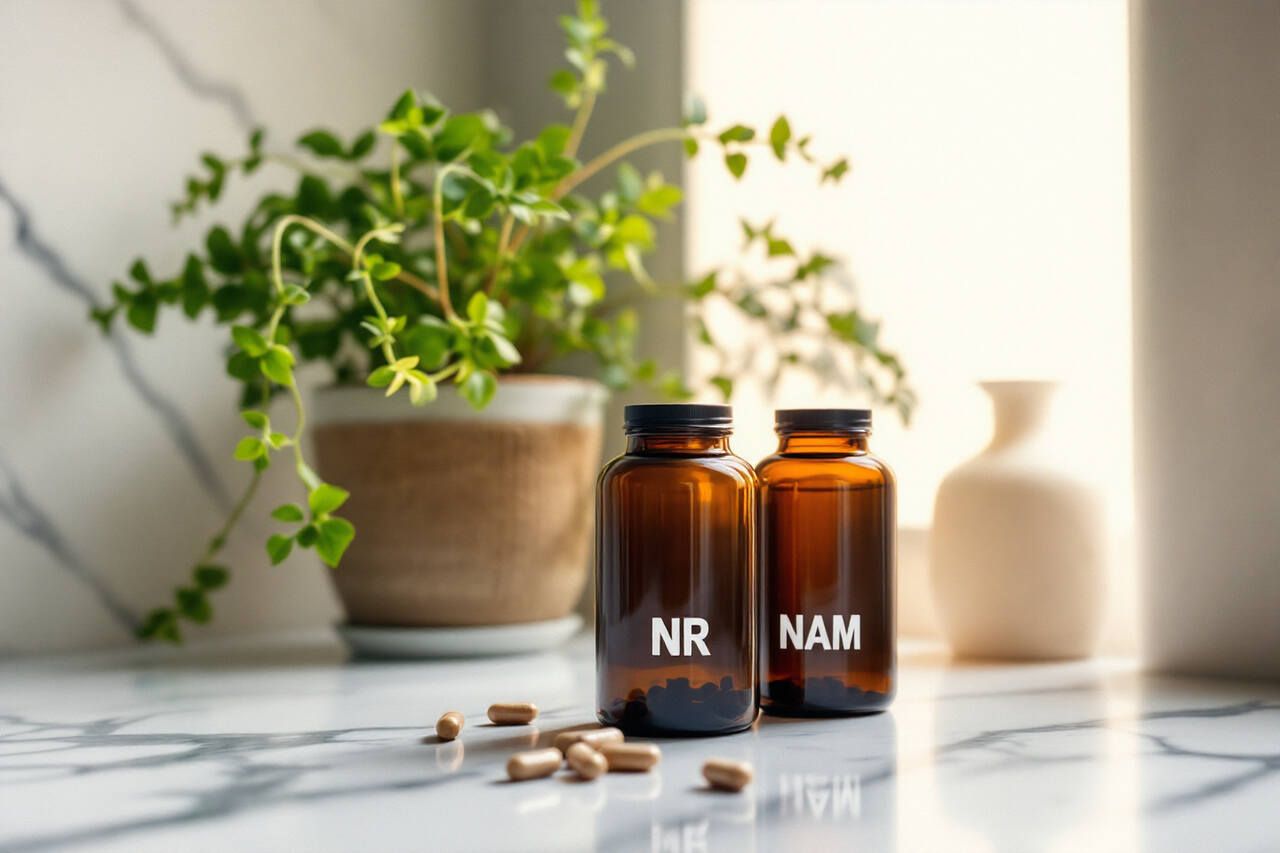5 Daily Practices to Support Mitochondrial Health
Ever feel like your body’s batteries need recharging? That’s essentially what your mitochondria do all day long.
These tiny cellular power plants transform what you eat and breathe into the energy that keeps you moving, thinking, and thriving.
When they work well, you feel energized and clear headed. When they struggle, so do you.
Luckily, science has uncovered daily practices that can supercharge these microscopic energy factories.
Read on to discover how simple lifestyle adjustments can support mitochondrial function and revitalize your cellular batteries.
Key Takeaways
- Mitochondria generate 90% of your body’s energy and play crucial roles in cell repair and immune function
- Exercise stimulates the creation of new mitochondria, improving energy production capacity
- Quality sleep and stress management are essential for mitochondrial maintenance and repair
- Intermittent fasting activates pathways that enhance mitochondrial performance and cleanup
- A diet rich in antioxidants and healthy fats protects mitochondria from damage and supports function
Why is Mitochondrial Function Important?

What exactly runs the show deep inside your cells? Meet the mitochondria. They are essential for your health at the most basic level.
Most known for energy production, they generate about 90% of the ATP your body needs.1 This is the fundamental fuel for life’s processes.
However, their influence stretches much further. Mitochondria are critical multitaskers:
- Powering You: Creating cellular energy (ATP)
- Cellular Maintenance: Playing a key role in cellular repair signals2
- Immune Guardians: Helping regulate immune responses3
- Calming Inflammation: Assisting in controlling inflammation4
Over time, their performance can naturally decline. This slowdown contributes directly to common signs of aging like fatigue and reduced mental clarity.
Strengthening mitochondrial function offers real benefits. Research shows it can combat age related decline.5 It boosts energy and overall physical resilience.
Ultimately, supporting mitochondria means supporting your body’s core ability to function well and repair itself. It’s a cornerstone of lasting wellness and longevity.
Common Signs of Mitochondrial Dysfunction

Feeling constantly tired? Having trouble thinking clearly? Your mitochondria might be trying to tell you something.
When these cellular powerhouses aren’t working well, your body feels it. Most people don’t realize their mitochondria are struggling until several symptoms start adding up.
Watch for these warning signs:
- Feeling exhausted even after a full night’s sleep
- Struggling to focus or remember things
- Muscles that feel weak or take forever to recover
- Getting winded easily during exercise
- Feeling older than your actual age
If this sounds like you, don’t worry. Supporting your mitochondrial health can boost your energy, mental clarity, and overall vitality. Your body has an amazing ability to bounce back when you give it what it needs at the cellular level.
5 Practices to Boost Your Mitochondrial Health

Give your cellular powerhouses the support they need with these simple but effective daily habits that enhance energy production at the most fundamental level.
1. Optimize Your Diet for Mitochondrial Support
Want to give your mitochondria a boost? Start with what’s on your plate!
Your mitochondria thrive when you feed them the right nutrients:
- Load up on antioxidants from berries, leafy greens, and even dark chocolate. These natural defenders protect your mitochondria from the damaging byproducts of energy production.6
- Embrace healthy fats like omega-3s found in salmon, walnuts, and flaxseeds. They keep mitochondrial membranes flexible and functioning well.
- Choose quality proteins from eggs, lean meats, and legumes to provide the building blocks your body needs for mitochondrial repair.
- Don’t forget micronutrients that power energy production: B vitamins from greens and nuts, magnesium from seeds and whole grains, and CoQ10 from fatty fish.7 8
Simple food swaps like adding spinach to your morning smoothie or snacking on blueberries can energize your cells from the inside out!
Bonus Read: While food should be your foundation, our guide to the best evidence-based mitochondrial health supplements options explores additional ways to nourish your cellular energy systems when diet alone may not be enough.
2. Exercise for Mitochondrial Biogenesis
Regular exercise triggers your body to make new mitochondria and upgrade existing ones. Here’s how to get the most benefit:
Go long with cardio. Activities like brisk walking, cycling, or swimming for 30 minutes daily can increase your muscle cells’ mitochondrial volume by up to 40%!9 This means more energy production with less effort.
Try HIIT for efficiency. Short bursts of intense activity (30 seconds all-out, 90 seconds recovery) are particularly effective at boosting mitochondrial function.10 Just 2-3 sessions weekly can deliver impressive results in minimal time.
Don’t skip strength training. Resistance exercises improve how your mitochondria process proteins and respond to insulin, both crucial for cellular energy.11
Remember to recover properly with good hydration, quality sleep, and even foam rolling, which surprisingly may help support mitochondrial formation by improving circulation.
Your mitochondria respond quickly to movement, making exercise one of the most powerful tools for cellular health.
Precision Testing for Mitochondrial Function
At Jinfiniti, our AgingSOS® panels provide precise measurements of your mitochondrial function through multiple biomarkers. This data reveals exactly where your energy production systems need support – information impossible to get from symptoms alone.
Athletes using AgingSOS® testing have identified specific biomarkers limiting their performance. Others have discovered hidden inflammation sabotaging their mitochondria despite perfect nutrition and training.
Take the first step toward optimal cellular energy. Test your mitochondrial function with AgingSOS® and build your health optimization plan on measurable data, not assumptions.
3. Prioritize Sleep and Stress Management
Your mitochondria can’t perform at their best when you’re exhausted and stressed out. Here’s why rest and recovery matter so much.
When you sleep deeply, your body runs essential maintenance, clearing out damaged mitochondria and building fresh ones. But missing those precious hours means this cleanup crew never shows up for work.
Meanwhile, stress hormones flooding your system create a toxic environment where mitochondria struggle to function.
These simple daily habits can improve your mitochondrial health:
- For better sleep: Create a cool (65-68°F), dark bedroom sanctuary without electronic devices. Stick to consistent sleep times and give yourself a screen-free wind-down period before bed.
- For stress relief: Even brief practices make a difference. Try the 4-7-8 breathing technique (inhale 4, hold 7, exhale 8) to quickly shift your nervous system into recovery mode.
- For recovery: Surprisingly, massage has been scientifically shown to stimulate new mitochondrial growth by activating specific cellular pathways.12 Other relaxing activities like stretching or warm baths support mitochondrial health too.
Remember: your energy at the cellular level depends on how well you balance activity with recovery. Just 5-10 minutes of daily relaxation can create significant benefits over time.
4. Practice Intermittent Fasting
Giving your digestive system a break can supercharge your cellular energy factories! Intermittent fasting creates powerful shifts in your metabolism that help your mitochondria work better.
What happens when you fast:
Your body activates cellular pathways that boost mitochondrial performance.13 Fasting increases important proteins called sirtuins that regulate cellular health and raises levels of NAD+, a crucial molecule your mitochondria need for energy production.14 Your body also starts producing ketones, a clean alternative fuel that your mitochondria love.
Even more importantly, fasting triggers “mitophagy,” your body’s way of removing damaged mitochondria and replacing them with healthy new ones.15 Think of it as regular maintenance that keeps your cellular power plants running efficiently.
As a bonus, studies show fasting helps reduce inflammation and oxidative stress that can damage mitochondrial membranes.16
Easy ways to start:
- Try a simple 12-hour overnight fast (finish dinner by 7 PM, eat breakfast at 7 AM)
- Once comfortable, explore the 16/8 method (16 hours fasting, 8 hours eating)
- For a different approach, consider the 5:2 method (eat normally five days, reduce calories to 500-600 on two non-consecutive days)
Start with shorter fasting periods and gradually extend them as your body adapts. Monitor how you feel to find what works best for your unique system. The goal is to support your cellular energy, not create additional stress!
5. Minimize Toxic Exposure
Your mitochondria are sensitive to toxins that can damage them and reduce their efficiency.17
Here’s how to create a cleaner environment for optimal cellular energy:
Avoid hidden toxins:
- Check household cleaners, cosmetics, and food containers for harmful chemicals
- Replace products containing parabens, phthalates, and BPA with natural alternatives
- Choose BPA-free containers and toxin-free personal care items
Support natural detoxification:
- Stay well-hydrated to help flush toxins from your system
- Eat plenty of fiber to remove waste through your digestive tract
- Include detox-supporting foods like leafy greens, berries, and cruciferous vegetables
Nurture your gut microbiome:
- Feed beneficial bacteria with prebiotics found in garlic and onions
- Add fermented foods like yogurt and kefir for probiotics
- Remember: a healthy gut supports healthy mitochondria!
Your cellular power plants work best in a clean environment. Simple changes make a big difference!
Your Mitochondrial Support Plan: Putting It All Together

Improving mitochondrial function isn’t about quick fixes, it’s about creating healthy habits that work together. Here’s how to build your own mitochondrial health plan:
Start small and build gradually:
- Choose just one practice to begin with
- Add a handful of antioxidant-rich foods to your meals
- Try a 20-minute daily walk or commit to consistent sleep times
- Begin with a manageable 12-hour overnight fast
Watch for signs of improvement:
- Increased energy and mental clarity
- Better exercise performance and recovery
- Improved mood and skin health
- Reduced inflammation and fatigue
Remember these key principles:
- Each practice enhances the others—they work better together
- Consistency matters more than perfection
- Small daily habits create powerful cellular changes over time
For deeper insights into your progress, consider the AgingSOS Advanced Longevity Panel from Jinfiniti, which measures key biomarkers of cellular health and aging. This test provides actionable information to help you fine-tune your mitochondrial support plan.
Your mitochondria respond quickly to positive changes! By implementing these five practices, you’re supporting the fundamental energy systems that power every cell in your body.
Referenced Sources:
- https://www.sciencedirect.com/science/article/pii/S0925443916302927 ↩︎
- https://pmc.ncbi.nlm.nih.gov/articles/PMC2666190/ ↩︎
- https://www.frontiersin.org/journals/immunology/articles/10.3389/fimmu.2023.1166214/full ↩︎
- https://pmc.ncbi.nlm.nih.gov/articles/PMC7141240/ ↩︎
- https://pmc.ncbi.nlm.nih.gov/articles/PMC8037956/ ↩︎
- https://pmc.ncbi.nlm.nih.gov/articles/PMC4350006/ ↩︎
- https://www.sciencedirect.com/science/article/abs/pii/S0009279706000998 ↩︎
- https://pmc.ncbi.nlm.nih.gov/articles/PMC3097389/ ↩︎
- https://journals.physiology.org/doi/full/10.1152/physiol.00038.2018 ↩︎
- https://pmc.ncbi.nlm.nih.gov/articles/PMC8294064/ ↩︎
- https://pmc.ncbi.nlm.nih.gov/articles/PMC5605648/ ↩︎
- https://pubmed.ncbi.nlm.nih.gov/22301554/ ↩︎
- https://pmc.ncbi.nlm.nih.gov/articles/PMC5942780/ ↩︎
- https://pmc.ncbi.nlm.nih.gov/articles/PMC5525320/ ↩︎
- https://www.nature.com/articles/s42003-025-07541-x ↩︎
- https://www.nature.com/articles/s41598-025-86734-0 ↩︎
- https://pmc.ncbi.nlm.nih.gov/articles/PMC9729331/ ↩︎
















































